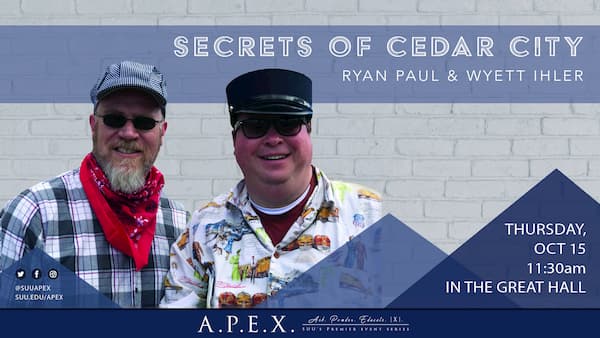
Secrets of Cedar City with Ryan Paul & Wyett Ihler
October 15, 2020
The Great Hall
Reflection | Podcast | Video | Photos
Sharing their research from their YouTube series, "Main Street Minutes," Ryan Paul and Wyatt Ihler will give you stories and historical events of our beloved Cedar City! Come learn the stories of our city's history and some secrets you didn't know before!
Reflection
APEX Events was pleased to host Ryan Paul and Wyett Ihler, hosts of the YouTube series, “Main Street Minutes,” to our university to share with our community the wonderful history and little-known facts about our beloved Cedar City. They shared some of the stories that made Cedar City what it is today, and the process of discovery of our city’s great history. Ryan and Wyett gave their presentation on Thursday, October 15, 2020 in the Great Hall and were introduced by SUU’s Dean of the College of Humanities and Social Sciences, Dr. Jean Boreen.
Joined onstage with Dr. Lynn Vartan, Ryan and Wyett began their presentation by sharing with the audience the story behind the creation of “Main Street Minutes” and then showing one of the videos on their YouTube page - the story behind the Bank of Southern Utah. During Christmas Eve in 1931, the effects of the Great Depression had been in the position of being unable to meet state mandated legal reserve, and it had been decided that the bank would close its doors. In February 1904, Nathan T. Porter, the President of the Branch Agricultural College (now Southern Utah University) was convinced that for this community to move beyond its current rural barter and trade economy, a strong financial institution was needed, and thus the Bank of Southern Utah was born. By making cash money easier to come by, the volume of business increased in Cedar City by 25% and by 1925, the bank had become a valuable asset to the community and was ready to move into a new building.
The duo shared and discussed another video with the audience, this time talking about the old Cedar City Rock Church. Also around the same time as the Great Depression, federal funds were offered to build a new post office and the community decided that the perfect spot was where the tabernacle stood. However, one local congregation of the Church of Jesus Christ of Latter Day Saints, the first ward, still met in the old building. Bishop Franklin B. Wood, the ecclesiastical leader of the first ward, was determined to build a new chapel east of the tabernacle. Local contractor George Wood, who had designed many of the structures at Bryce Canyon and the north rim of the Grand Canyon, was selected as the architect. He submitted a tutor style design based on the architecture he'd seen during his travels in Europe and argued for the use of local materials in the building's construction, but many locals and church officials had trouble visualizing Wood’s design and opposed his plan. After convincing them that local materials would save money, the design was approved and construction began. As proposed by Wood, local material was used to construct the church, and most impressively, rock from the surrounding hills collected, sorted by color, and incorporated into the walls, giving the church its name. June 15-20, 1931 was proclaimed as “Rock Week”.
The last video shown by Paul and Ihler was about the town historic Cedar Theater. In 1924 the Fox Film Corporation announced that the world's most popular cowboy Tom Mix would shoot his next film, “Deadwood Coach” in the area. Not only would this be the first movie filmed locally in Cedar City, it would be the first one shot in Utah. Shortly afterwards, movies such as “The Good Earth,” “Union Pacific,” “Drums Along the Mohawk,” “Brigham Young,” “Can't Help Singing,” “My Friend Flicka” and “Proud Rebels” were all filmed in Cedar City and surrounding areas. After a number of name changes, the theater became known as the Cedar Theatre in the 1950’s and is the last of the traditional theater houses.
- By Emily Sexton





































